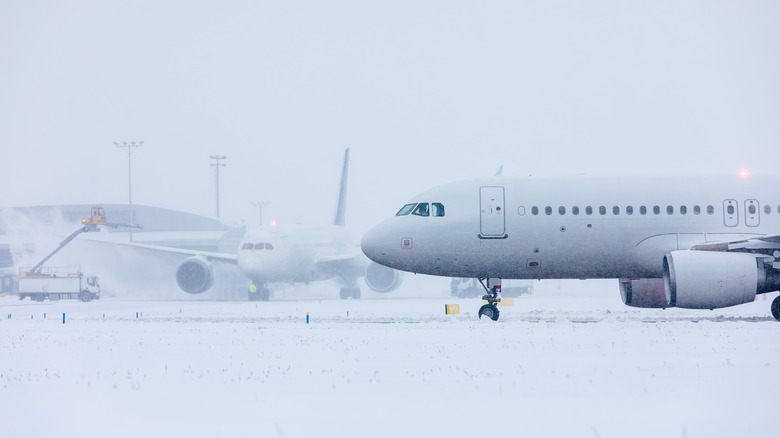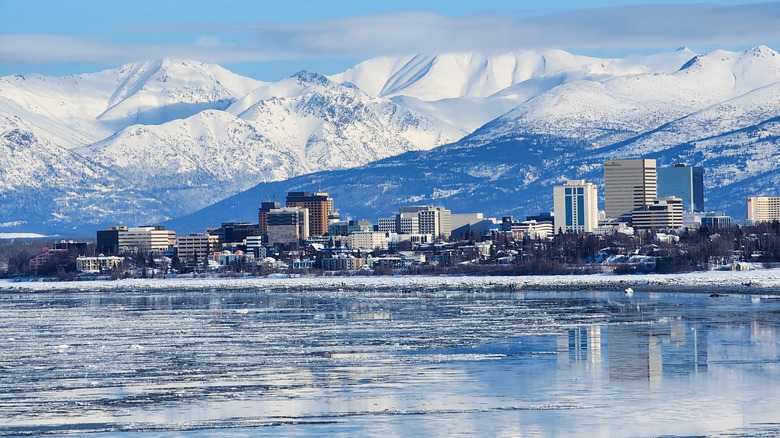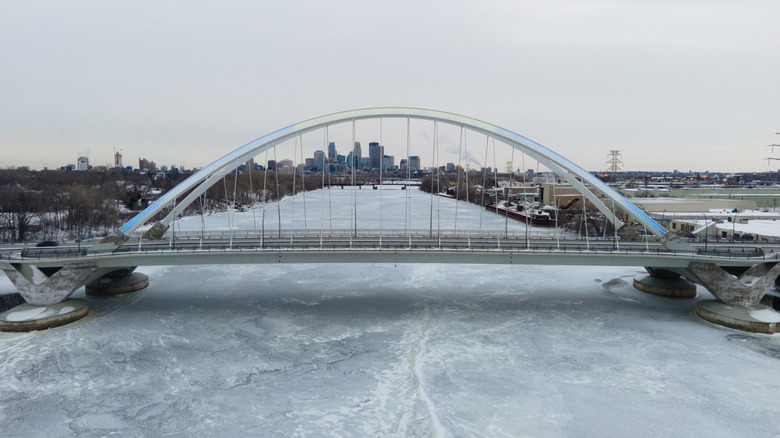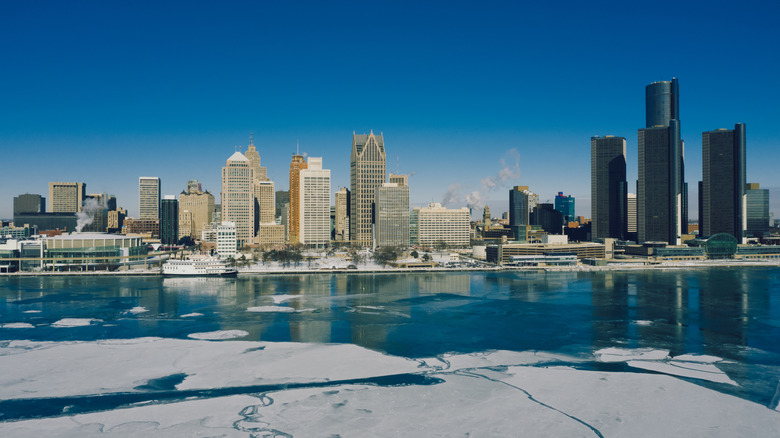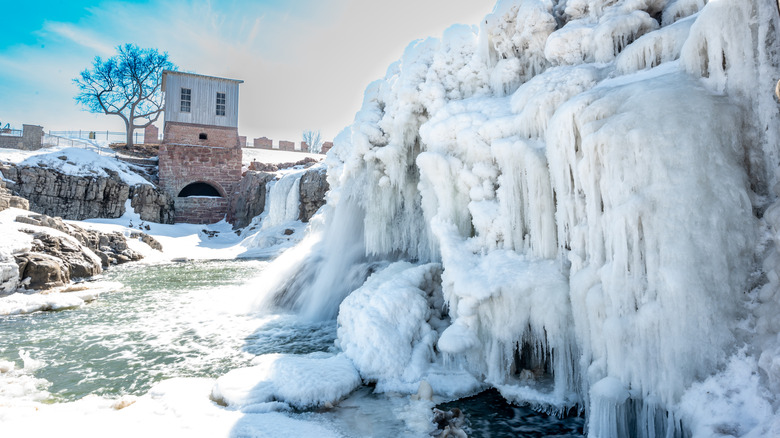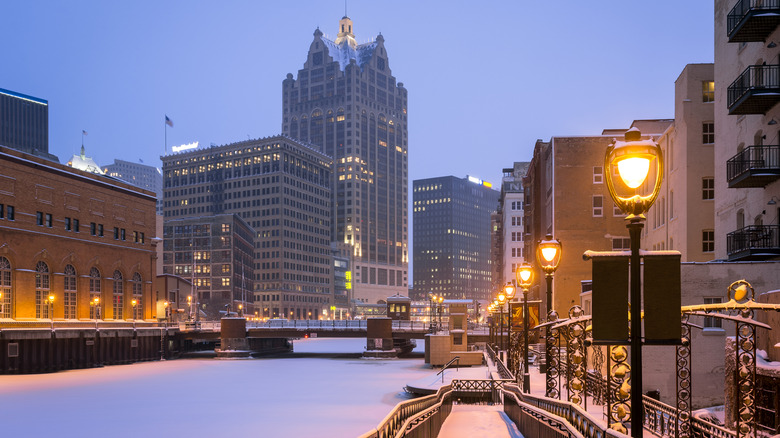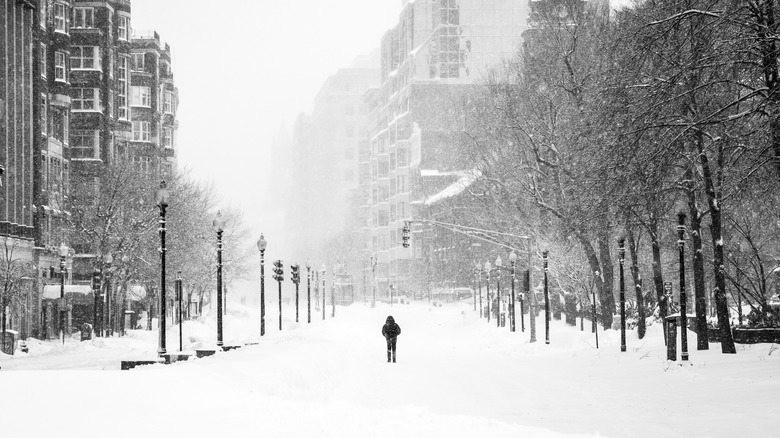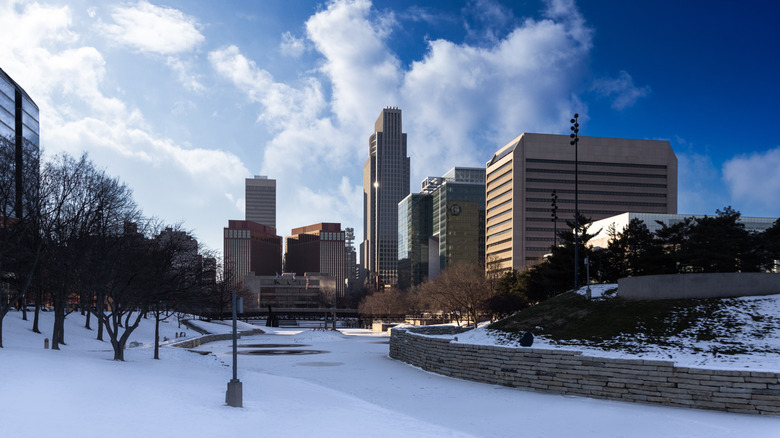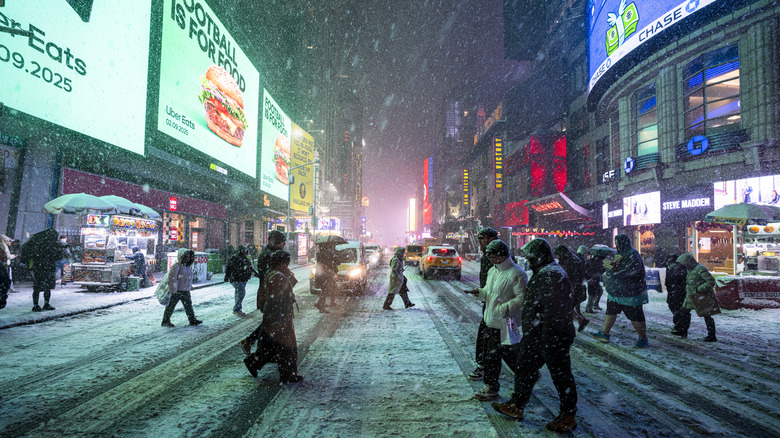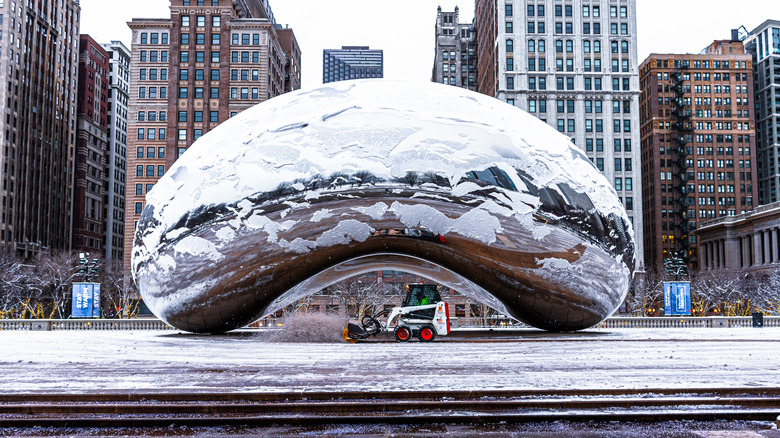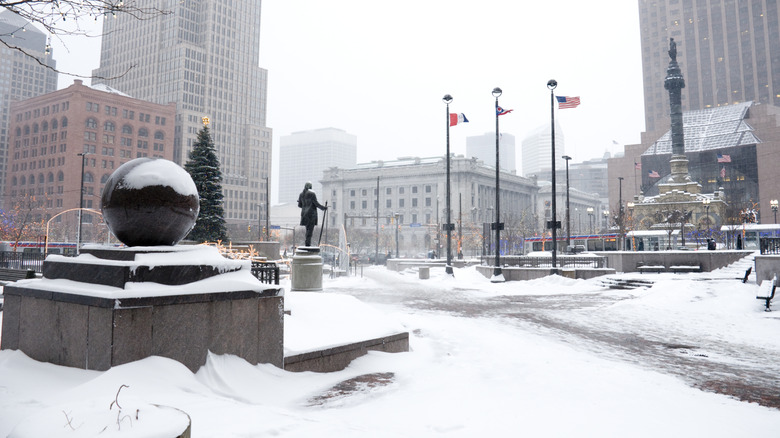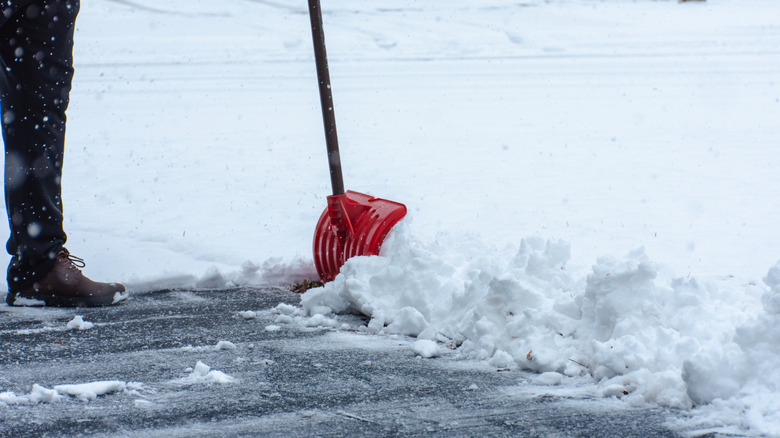10 U.S. Cities Tourists Might Want To Avoid Visiting For Winter Travel Plans
There are many places in the United States where winter can be a magical time to travel, but the cold season also comes with its risks. Snow can be delightful if you're hoping for fresh powder on the ski slopes, but most of the time, it causes a headache. Between harsh snowstorms and icy roads, the unpredictable weather patterns of winter make some cities less appealing to visit during the coldest and darkest time of year — especially if you need to travel through an airport or traverse the interstate. Travelers shouldn't underestimate the harsh realities of traveling during winter, when plans can be upended with a spell of bad weather.
In the United States, some of the most notorious regions for bad winters can be found around the Great Lakes and in the Northeast, so if you have these regions on your travel radar, it might be best to save them for another time. Sometimes winter travel in these regions can't be avoided if you have a business trip or are called upon to visit relatives for the holidays, in which case you can make the most of it — and still find attractions and activities to make the trip worthwhile — but you should know what to expect. If you're trying to escape the bad winter weather at home, consider a budget-friendly alternative somewhere with warmer weather.
Anchorage, Alaska
Despite its charms and beauty, Alaska's Anchorage has been called the most depressing city in America during the winter. Located in the country's northernmost state, winters in Anchorage are dark and bleak, with the city receiving less than six hours of sunlight between December and January. According to a study by SmartAsset, the city only receives 34% of direct sunlight between November and February. Travelers might underestimate how disorienting the lack of light and long stretches of darkness can be.
January is the coldest month, with average temperatures ranging between 13 and 23 degrees Fahrenheit, and average highs stay below the freezing point until March. For tourists, the cold weather and dark days can be very depressing, but winter storms also disrupt travel. In 2024, 100 inches of snow fell on the city, and the snow was preceded by severe 75 mph winds that knocked out power for thousands of residents.
Summer is a much better time to visit Anchorage (and the rest of the state). Alaska is best enjoyed on a scenic cruise, during which you'll be surrounded by the spectacular nature of the Last Frontier. However, if you do wind up in Alaska's biggest city during the winter and find it too cold to be outside, you can find cozy refuge at the Anchorage Museum, where you'll learn a mix of Alaskan history and culture.
Minneapolis, Minnesota
Blizzards, ice-covered roads, and bitter cold are the mainstays of winter in Minneapolis. With average temperatures ranging between 21 and 33 degrees Fahrenheit from December to February, visitors will need to bundle up with many layers to survive a winter trip to the City of Lakes. Although it's not located on any of the Great Lakes (Lake Superior is the closest), Minneapolis still receives much of the wind chill common in the region. Try to imagine the chill as the cold air from the north rips across the surface of a iced-over water. This weather effect also makes snow events more intense, so if you don't have good boots, you are going to struggle to get around town. The city invests heavily in removal, but the frequency of the storms can make it challenging for snowplows to keep up.
Winter storms — with sleet and freezing rain — can be relentless, frequently delaying flights at Minneapolis-St. Paul International Airport. However, while Minneapolis can be quite desolate in the winter when everyone stays inside (the city even has a unique skyway system that allows people to get around the city without braving the outside), summer sees the city come back to life with festivals and watersports on the lakes. If you must visit during the winter, you can find plenty to keep you entertained on a trip to Bloomington, home to the Mall of America. The largest mall in the country, the Mall of America even has an indoor amusement park.
Detroit, Michigan
Winters in Detroit are cold, snowy, and known for the occasional blizzard, so this is not a place you want to visit in the off-season (unless traveling in blizzards is your jam). Between December and January, temperatures drop to below freezing with average highs of about 31 degrees Fahrenheit. That's enough to freeze the Detroit River, which is a beautiful sight if you can withstand the bitter chill of the winter wind. These low temperatures mean that sidewalks are icy, and most Motor City residents tend to stay indoors (when they're not shoveling snow, of course). Detroiters also know that the weather can be quite random, so even if it appears sunny and warm one day, frigid temperatures can arrive out of nowhere. Expect sudden thaws followed by freezes, which lead to the formation of dangerous sheets of black ice that are difficult to see.
If you do find yourself exploring Detroit in the winter, there are many cozy cafes to warm up in, and you can find some relief from the cold at indoor museums like the impactful Charles H. Wright Museum of African-American History. The Detroit Institute of Arts Museum also has an extensive collection with multiple galleries and exhibits on local history, fashion, American, and ancient art, including numerous works by Vincent Van Gogh. After all, there's a reason why they call Detroit the Paris of the West.
Sioux Falls, South Dakota
South Dakota has severe winters, which you should be aware of if you're considering a trip to Sioux Falls, the state's largest city. The Queen City of the West, which sits on the Missouri River, experiences winter temperatures ranging from 10 to 35 degrees Fahrenheit. Conditions range from freezing to frigid, so if you're not fond of the cold, this place will be a struggle.
Winters can also be extremely overcast, with an average snowfall between 2 and 3 inches a month. The primary thing that will be most unbearable to visitors is the wind, which can make temperatures below freezing feel even sub-zero, particularly in January. Not only is it uncomfortable, but the combination of constantly cloudy skies and bitter temperatures can also be somewhat depressing.
Most travelers come here for outdoor activities and attractions like Mount Rushmore or Badlands National Park, so it is wise to wait to visit until the weather warms up. If you are looking for something to do indoors in Sioux City, the Washington Pavilion is your one-stop shop for live theatre, a science museum, and art galleries. You could easily spend the whole day there.
Milwaukee, Wisconsin
Lake Michigan makes winters in Milwaukee very tough to deal with. Wisconsin's Brew City experiences winter temperatures between 18 and 40 degrees Fahrenheit, with an average snowfall of over 4 inches in January and February. Locals are used to the icy roads and know the importance of having a reliable pair of snow boots to keep their feet dry, but the city generally does a decent job of keeping roads clear. After all, snow is the norm. Not to mention, the popular RiverWalk can become very icy, creating treacherous walking conditions, and it always feels colder and windier when you're walking along the water. If you're visiting Milwaukee in the winter, chances are you'll want to spend the majority of your time indoors to avoid the bitter discomfort of the cold wind and wet snow.
Thankfully, there's plenty of comfort food to warm you up in the Culinary Capital of the Midwest, which is home to many restaurants helmed by chefs who have been recognized with James Beard Awards or "Top Chef" appearances. The city also has a fantastic roster of dive bars, as would be expected from a destination famous for its beer culture. You probably won't be doing much city exploration on foot in winter, but you can get a few steps in at the Milwaukee Public Museum. The museum has engaging exhibits on natural history and a planetarium with a giant dome screen, showcasing programs on subjects such as outer space and dinosaurs to help you forget about the chilly weather outside.
Boston, Massachusetts
Boston is a vibrant city year-round, but its nor'easters are legendary. These are intense coastal storms that arrive with icy winds and dump loads of snow across New England. They can also cause coastal flooding, which leads to travel delays and infrastructure damage as the falling snow melts into the ocean, raising the overall water level. These snowstorms frequently block things up at Logan Airport, as well as the streets in the oldest parts of the city, which can often be narrow and difficult to navigate. The storms can last for days, leading to marathon-length shoveling sessions for locals, and high competition for parking spaces in the crowded city. In the surrounding neighborhoods, you will sometimes see people claiming the empty parking space they worked hard to clear with a lawn chair. The commuter trains may also experience delays, which could result in increased traffic.
Temperatures are not quite as cold as in other cities on this list, with average temperatures ranging from 23 to 46 degrees Fahrenheit. However, Boston's tourists do tend to spend more time outside, as many of the attractions (such as the fascinating Freedom Trail) are walkable. There are plenty of museums, such as the Museum of Fine Arts and the Museum of Science, if you need to avoid the bitter cold. However, if you find yourself in town on a more bearable day, you can also take advantage of ice skating on the Boston Common Frog Pond.
Omaha, Nebraska
Smack-dab in the middle of the country in the famously flat plains of Nebraska, Omaha has some pretty tough winters. The weather is not predictable and can bring a mix of snowstorms, freezing rain, and average temperatures ranging from 17 to 44 degrees Fahrenheit. That's pretty cold, but it's the sudden blizzards that catch most travelers off-guard, with winds bearing down between 50 and 70 mph. These gusts that come ripping across the plains can make even short walks feel like a full-on battle against the elements. Between December and February, the average snowfall is less than 4 inches, but a bad storm can drop up to 9 inches on a neighborhood in record time.
If you get caught in Omaha during a storm and need help passing the time, the Omaha Zoo has impressive indoor exhibitions, including the world's largest indoor desert. In addition to the hundreds of species you can see on a visit here, the Desert Dome will help you forget about the weather outside and transport you physically to somewhere warm and toasty.
New York, New York
New York is the city that never sleeps, but that doesn't mean visiting the Big Apple in the winter is a walk in the park. Freezing winds cut through the skyscrapers, and slushy puddles of melted snow are lying in wait to ruin your day, and the city isn't immune to the random snowstorm or nor'easter. January is the coldest month, with temperatures ranging from 31 to 42 degrees Fahrenheit, dropping to below freezing after dark. It's also the snowiest, averaging over 6 inches of snow, which can cause major traffic and subway delays. Nor'easters can do significant damage through heavy snows and flooding, and you'll be dealing with dirty slush for weeks after the snowstorm ends. And if the temperature drops below freezing, your risk of slipping on black ice goes up. All in all, it isn't the most pleasant of mixes.
If you visit New York City in the winter, pack lots of layers, waterproof boots, and a good winter coat. You'll likely want to avoid spending time outside in the bitter cold, which is easy to do with plenty of Broadway shows, museums, and fantastic restaurants to choose from. NYC remains packed with tourists during the winter, but it is best avoided if you're not a fan of cold weather.
Chicago, Illinois
There's a reason they call Chicago the Windy City. The largest city in the Midwest is notorious for bitter winters, lake-effect snow, and the fierce winds of Lake Michigan that gave the city its nickname. After New Year's Day, you can count on average temperatures somewhere between 22 and 34 degrees Fahrenheit until the end of February, which is nearly two months of temperatures hovering around freezing point. Snowfall is steady, with an average of between 2 and 4 inches in January and February.
Chicagoans are accustomed to the day-to-day inconveniences of snow, but major storms can still shut down the city from time to time. These blizzards are notorious for causing issues at Chicago O'Hare Airport, which is the most likely airport in America to experience winter delays. The airport's status as a transfer hub in the Midwest means that storms in Chicago can cause travel delays all over the country.
The Second City is a much more lively place in the summer, but winter tourists can still find plenty to enjoy in this cultural hotspot. After all, it's home to the Art Institute of Chicago, which has one of the most impressive art collections in the country, featuring American classics such as Grant Wood's "American Gothic" and Edward Hopper's "Nighthawks."
Cleveland, Ohio
Winters and Cleveland are also shaped by lake-effect snow originating from Lake Erie. If you visit the Forest City in winter, expect gray skies and frequent flurries. You won't get a lot of sunlight as the sky is consistently overcast. January is the coldest month, with temperatures ranging from 22 to 37 degrees Fahrenheit, and the city gets more and more snow on average as you get deeper into February. Ohioans survive winter with good snow boots and frequent moisturizing to prevent dry skin and chapped lips, but unfortunately, it doesn't prevent airport delays. If you're flying into Cleveland with a blizzard on the horizon, don't be surprised if your flight gets diverted.
If you do wind up in Cleveland during a cold spell, head to the Rock and Roll Hall of Fame, where music lovers will find fascinating exhibits and an exciting journey through the history of the cultural phenomenon. It's one of the most iconic attractions in the city; it's worth checking out whatever the weather. However, it is extra perfect when the weather outside is less than ideal. After all, it is difficult to play guitar with numb fingers.
Methodology
These cities were selected firstly for their reputation as major travel destinations and the frequency of experiencing harsh winter conditions. Climate data was sourced from WeatherSpark to determine average temperatures and snowfall, and tourism boards and local forums were researched to find frequent experiences during the winter. Additional sources, such as news reports, local anecdotes, and past reporting on major storms, were also reviewed to provide a broader context for how winter weather impacts residents and visitors.
Many cities are located in the Midwest, particularly around the Great Lakes, as this region experiences the most lake-effect snow, which is one of the biggest determinants of potential interruptions that could ruin a trip. The effect of cold air sweeping across the flat surface of a lake doesn't just mean strong, uncomfortable winds, but it can actually exacerbate winter storm conditions. Cold snaps and blizzards are also common in these areas, creating hazardous conditions for travelers on roads and highways. If you do decide to visit any of these delightful destinations in winter, dress accordingly and plan plenty of indoor activities, such as those mentioned in this article.
